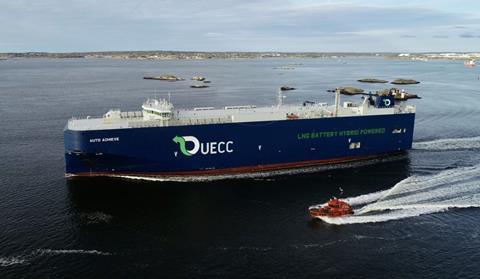Pure car and truck carrier (PCTC) owner and operator UECC has adopted a standardised methodology based on an existing and trusted industry framework to address the upcoming EU Emissions Trading System (EU ETS).

Set to be phased in for shipping from January 1, 2024, EU ETS will require shipping companies calling at European ports to purchase EU Allowances (EUAs), or carbon credits, corresponding to each tonne of CO2 emitted to cover their annual emissions. This is effectively a tax on the use of fossil fuels in line with the price of EUAs, currently at around EUR80 (USD87), with these costs to be distributed across the value chain based on the ‘polluter pays’ principle that underpins the regulation.
Cargo owners seeking to determine their Scope III emission liabilities from the logistics chain must contend with multiple calculation methods from different shipping lines that will affect their costs exposure to the EU ETS for shipping.
“Having to relate to shipping lines’ possible different formulas for calculation of emissions costs both increases the administrative burden and creates confusion for cargo owners. This can also result in higher costs for clients due to overcharging and, consequently, inequitable distribution of EUA liabilities across the value chain,” said UECC’s energy and sustainability manager Daniel Gent.
This could, for example, lead to a situation where a cargo owner receives a Scope III footprint of 2,000 tonnes of CO2 emissions based on transport work undertaken, but is asked to pay for the equivalent of 3,000 tonnes of CO2 as the EU ETS cost is calculated based on other external factors, such as higher TC rates, bunker prices, etc. “A cargo owner has every right to expect to pay for the emissions generated as a result of its cargo shipment, not more and not less,” Gent explained.
UECC’s calculation formula is therefore based on the existing methodology for GHG emission accounting developed by the Association of European Vehicle Logistics (ECG) and Smart Freight Centre, together with UECC and other stakeholders, and incorporating ISO standards.
The ro-ro GHG emissions accounting guidance, UECC said, sets the standard for reporting of shipment emissions, transport activity and carbon intensities from multimodal transport operators to cargo owners and is intended to create a harmonised and transparent methodology for calculation and reporting of logistics GHG emissions for the ro-ro industry.
This is consistent with existing industry and international standards regarding carbon accounting for the logistics industry, namely the GLEC Framework and ISO 140832, said UECC.
Gent said this regime is already widely used by cargo owners to determine their Scope III emissions from transport and logistics for the purposes of ESG reporting and it is therefore logical that this should form the basis for UECC’s EU ETS calculation method.
“Our EU ETS solution is intended to provide clarity, transparency and predictability for clients so they can gain a correct picture of their emission costs, based on an equitable calculation of pricing that correlates to their actual carbon footprint. We believe this is a credible method that could form the basis for a uniform EU ETS formula that would be very much welcomed by the industry,” he explained.
The UECC formula calculates EUA costs for the cargo owner using its fleet average carbon intensity, or the average amount of CO2 emitted per CEUkm, which is the relative size of the cargo in cargo equivalent units (ceus) and the distance it is being transported.
Carbon intensity is multiplied by ceu volume and an adjusted figure for shortest feasible distance between port of loading and port of discharge to determine tonnes of CO2 emitted. This is then multiplied by the average EUA auction clearing price on the European Energy Exchange in a given reference period to give the final cost for the client.
UECC’s senior manager business planning and sustainability, Masanori Nagashima, added that a key factor in lowering the carbon intensity of shipments – and therefore EU ETS cost liabilities for cargo owners – is high utilisation of vessels to maximise cargo volumes per shipment, as well as customer support for green technologies to power ships. “This requires all industry stakeholders to work together and pull in the same direction towards decarbonisation of shipping,” he said.
















